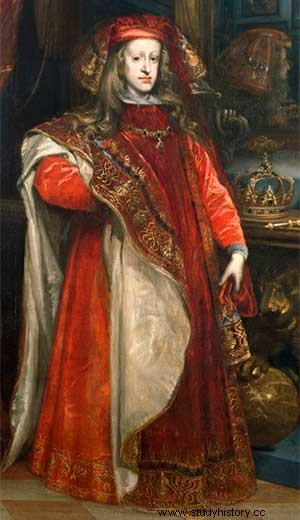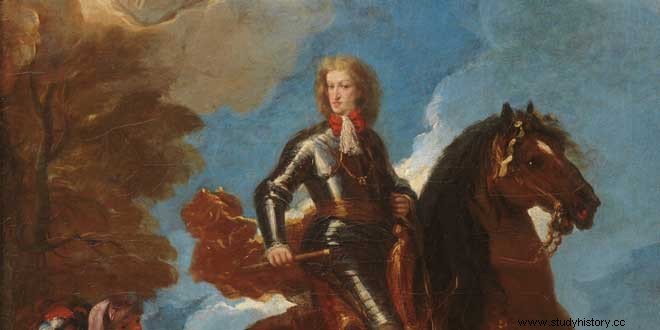Carlos II (the Bewitched) he was king of the Crowns of Castile and Aragon. He was born on November 11, 1661 in Madrid . He was the son of Philip IV and his second wife, Mariana of Austria. He ascended the throne on the death of his father, under the tutelage and regency of his mother, who admitted the German Jesuit Juan Everardo Nithard to the Regency Council, who was his favorite and confessor. of the; This gave rise to a confrontation between the latter and Juan José de Austria, who finally got the dismissal of the Jesuit. When he left, the queen made her favorite a young man (Fernando de Valenzuela) that the Jesuit had introduced to the Court; this caused much speculation; the queen made him marquis of San Bartolomé de Pinares and named him prime minister. War with Portugal resumed; but Spain had to recognize, in 1668, the independence of this kingdom; When the peace was settled, each country returned the conquered places to the other, with the exception of Ceuta, which remained in the power of the Crown of Castile.
On the other hand, Louis XIV of France declared war on Spain in 1667 , under the pretext that his wife was the only remaining heiress from Felipe IV's first marriage, and, in addition to being a minor when he signed the renunciation of the succession of the Crowns of Castile and Aragon, according to the right of return, that existed in Brabant, demanded that, his father-in-law having died, he be given this position and all the others where that right was observed. The Government of Carlos II refused, so the French, with an army of 50,000 men, entered the Netherlands and seized several places, while ordering the Prince of Condé to occupy the Franco with another army. -County. England, Holland and Sweden intervened to stop the aggrandizement of France, and Louis XIV had to sign the Peace of Aachen in 1668, by which Louis XIV was forced to return the Franche-Comté to Spain; but he kept the places he had occupied in Flanders. In 1673, Louis XIV led the medal war against Holland , resentful for having helped Spain in the War of Devolution; but with the intention of seizing the Spanish Netherlands, places between Holland and France; For this reason, Spain was again involved in war against France, with which it signed the Peace of Nijmegen on September 17, 1678; by means of this peace, Luis XIV returned, to Spain, some of the places that he had occupied in the Spanish Netherlands; but he stayed with others and with Franche-Comté.

On November 6, 1675, Carlos II was declared of legal age, and kept Valenzuela as prime minister, and gave him the title of Marquis of Villasierra; in 1676, he also made him the mercy of the greatness of Spain of the first class and declared him valid; but, fallen into disgrace, he was removed from the Government in that same year; Juan José of Austria replaced him, who retaliated against the friends of the queen mother; but, when he had arranged the marriage of Charles II with María Luisa de Orleans (1662–1689), daughter of Felipe de Orleans (brother of Louis XIV) and his wife, Henriette of England, he fell ill and died on September 17, 1679. The king's wedding, which had already been celebrated by proxy, was ratified on November 18 of the same year in Quintanapalla (Burgos). The Duke of Medinaceli was appointed Prime Minister; He immediately created the Treasury Board, which he called the Magna Board, which included Reluz (Franciscan and confessor of the king), Cornejo (Franciscan) and Asensio (Bishop of Ávila). The economic situation was so bad for the people that people shouted:“Long live the king! Death to the bad government!” Meanwhile, the king and his minister Medinaceli were busy visiting temples and sanctuaries, and attending autos de fe, such as the one held in the Plaza Mayor in Madrid on June 30, 1680, in which the prisoners burned at the stake , usually alive, were 118; Many people who lived around the Plaza Mayor complained about the smell of burning meat that they had to put up with. Louis XIV, alleging that the peace of Nijmegen was not fulfilled, occupied, in Flanders, the Spanish squares of Courtray and Dixmude in 1683; Carlos II declared war on the French; This responded by occupying the Luxembourg square and, penetrating into Catalonia, surrounded the city of Gerona. Finally, Carlos II accepted the peace that the French offered him, which materialized in the Treaty of Regensburg, signed on August 15, 1684; through which, Spain handed over, to France, the squares of Hainaut and Luxembourg.
In 1685, the Minister Medinaceli was banished, due to his mismanagement, to Cogolludo (Guadalajara), and he was succeeded by the Count of Oropesa, who eliminated many unnecessary jobs and improved the economy. On February 12, 1689, Queen María Luisa de Orleáns died without leaving descendants; so Carlos II remarried, on May 4, 1690, with María Ana de Baviera Neuburg (1667–1740), daughter of Felipe Guillermo (duke of Bavaria Neuburg and elector palatine) and Isabel Amelia de Hesse Darmstadt. The new queen soon seized the Charmed One's will, and, backed by the queen mother, she got the king to dismiss her prime minister; then, the government was left in the hands of the queen, Baroness Berlips (nicknamed the Partridge), Jovier Wiser (the Lame), Father Chiusa (the three Germans), the Count of Baños and Juan Angulo (the Mule), these characters , selling public positions and favors to the highest bidder, took administrative corruption to unprecedented limits.

In 1692, Luis XIV returned to enter war against Spain; he seized the Naur square in the Netherlands; then he sued for peace; but, since Spain did not accept it, he seized Barcelona and other Catalan cities. Finally, on September 20, 1697, the Ryswick Peace Treaty was signed, by which the French returned all the cities conquered to Spain during this war. In 1698, the Count of Oropesa returned to power; but at once he fell into disgrace again by intrigues, and was banished again. The king, who was often ill, suffered major nervous breakdowns. As he had not had offspring with either of his two wives, the candidates for the succession of the Crowns of Castile and Aragon began to present his candidates; these were six; but they were soon reduced to two:Charles of Austria (son of Emperor Leopold) and Philip, Duke of Anjou (grandson of Louis XIV of France). The intrigues for the throne began. Rumor spread that the monarch was under a spell. Rocaberti (inquisitor general) and Fray Froilán Díaz (confessor of Carlos II) convinced the king that his illness consisted in the fact that he had evil spirits, and he should undergo an exorcism ceremony; then they brought Fray Antonio Álvarez de Argüelles, a famous exorcist, who was a confessor to a nunnery in Asturias. The exorcism of the king was carried out, and the evil spirits "declared that the king's mother, now deceased, his wife, and other personalities of the Austrian party were to blame for everything."
The Austrian party, to defend itself, brought Fray Mauro Tenda (famous exorcist) from Germany, who returned to exorcise the Bewitched; "This time the demons launched tremendous accusations against those of the French party." Knowing the queen of so much farce, she managed to get the king's confessor to find her bones in the dungeons of the Holy Office. As it was seen that the disease finished with the king, the fight to succeed him was accentuated; Finally, the king, advised by Cardinal Luis de Portocarreño, member of the Council of State and Archbishop of Toledo, made his last testament on October 3, 1700 in favor of Philip of Anjou , a candidate who had been indicated by Pope Innocent XII (1691–1700). Shortly after, on October 27 of that same year, the King appointed Cardinal Portocarreño Regent of Spain. On November 1, 1700, Carlos II died in Madrid , leaving, to his successor, some kingdoms, in the Iberian Peninsula, with less than six million impoverished subjects; what was left in the main part of an empire where the sun never set. Also, due to the maneuver of the Archbishop of Toledo, Luis de Portocarreño, he left a war of succession, which, for Spain, would have disastrous consequences in the following reign.
